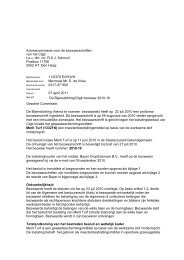Effects of neonicotinoid pesticide pollution of Dutch surface water on ...
Effects of neonicotinoid pesticide pollution of Dutch surface water on ...
Effects of neonicotinoid pesticide pollution of Dutch surface water on ...
Create successful ePaper yourself
Turn your PDF publications into a flip-book with our unique Google optimized e-Paper software.
Combining species abundance and imidacloprid c<strong>on</strong>centrati<strong>on</strong>s<br />
Measurements <str<strong>on</strong>g>of</str<strong>on</strong>g> imidacloprid c<strong>on</strong>centrati<strong>on</strong>s in the Netherlands were available from<br />
bestrijdingsmiddelenatlas.nl, but <strong>on</strong>ly for the years 1998 and 2003‐2007. Therefore, <strong>on</strong>ly the<br />
Limnodata sample data for those years could be analysed. Due to the nature <str<strong>on</strong>g>of</str<strong>on</strong>g> the data,<br />
comparing species abundance before the applicati<strong>on</strong> <str<strong>on</strong>g>of</str<strong>on</strong>g> <str<strong>on</strong>g>ne<strong>on</strong>icotinoid</str<strong>on</strong>g> <str<strong>on</strong>g>pesticide</str<strong>on</strong>g>s began, and<br />
during applicati<strong>on</strong>, was not possible.<br />
The distributi<strong>on</strong> <str<strong>on</strong>g>of</str<strong>on</strong>g> the locati<strong>on</strong>s at which imidacloprid c<strong>on</strong>centrati<strong>on</strong>s were measured is<br />
shown in Figure 4a; the locati<strong>on</strong>s at which abundance was assessed for the order Diptera are<br />
shown in Figure 4b.<br />
Fig. 4a. Positi<strong>on</strong>s <str<strong>on</strong>g>of</str<strong>on</strong>g> 579 imidacloprid measurement<br />
locati<strong>on</strong>s<br />
18<br />
Fig 4b. Positi<strong>on</strong>s <str<strong>on</strong>g>of</str<strong>on</strong>g> the 4479 Limnodata measurement<br />
locati<strong>on</strong>s for Diptera<br />
The files with the amounts <str<strong>on</strong>g>of</str<strong>on</strong>g> organisms found per locati<strong>on</strong> per date, and those with<br />
imidacloprid c<strong>on</strong>centrati<strong>on</strong> per locati<strong>on</strong> per date, were combined through a PHP script<br />
coupled to a MySQL database in which the imidacloprid measurements and the abundance<br />
data were stored. PHP stands for ‘Hypertext Preprocessor’ and is a scripting language<br />
originally meant for creating dynamic websites; MySQL is a system which acts as a server<br />
and can provide access to databases to many users (Wikipedia, 2010).<br />
The PHP script did the following:<br />
For each row <str<strong>on</strong>g>of</str<strong>on</strong>g> species abundance data, search for data points in the imidacloprid<br />
c<strong>on</strong>centrati<strong>on</strong>s file, which fall within a specified time frame and within a radius <str<strong>on</strong>g>of</str<strong>on</strong>g> 50 m<br />
from the sampling locati<strong>on</strong>;<br />
If more than <strong>on</strong>e c<strong>on</strong>centrati<strong>on</strong> measurement meets these requirements, take the<br />
unweighted average <str<strong>on</strong>g>of</str<strong>on</strong>g> these. This value is entered in the resulting file as imi0. If no<br />
values are found, imi0 = 0;<br />
Was imi0 > 0? If so, also enter its value as imi1, the value for a 1 km radius. If not, check<br />
again within a radius <str<strong>on</strong>g>of</str<strong>on</strong>g> 1 km and again take the unweighted average <str<strong>on</strong>g>of</str<strong>on</strong>g> all values found;



